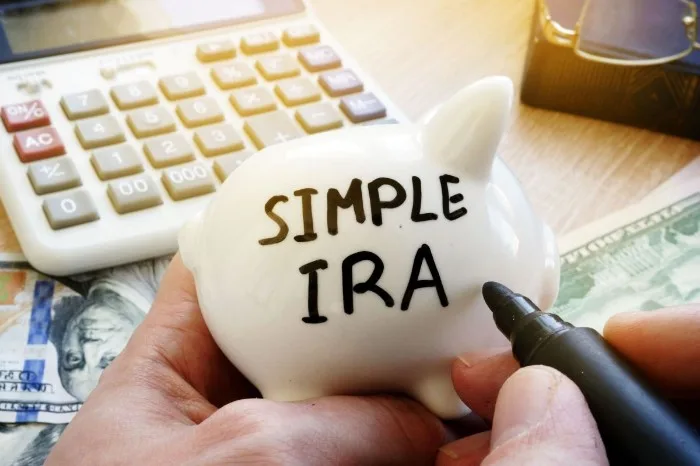Self-employed people, particularly freelancers and those running small businesses, should take careful consideration in planning for their retirement.
Among the numerous retirement savings options available, self-employed individuals often choose Simple IRA and Simple 401(k) plans due to their versatile nature and ease of implementation.
To empower self-employed individuals to make the most suitable decision regarding their retirement savings, this article will delve into a comparison of the two best plans available.
We’ll go through each plan in detail and help you pick out what’s right for your needs.
Comparison of Simple IRA and Simple 401(k) Plans for Self-Employed Individuals

To help self-employed individuals determine which retirement savings plan is most beneficial for them, let’s analyze the features of Simple IRA and Simple 401(k) plans side by side.
Simple IRA
Ready to save for your retirement with a tax advantage?
Look no further than Simple IRA (Savings Incentive Match Plan for Employees)!
With this plan, self-employed individuals can make the most of their hard-earned money and ensure they have financial security in their later years.
Setting up and managing a Simple IRA is an effortless choice when it comes to individual retirement accounts.
This plan is available to solo entrepreneurs who employ fewer than 100 people.
Key takeaway: Simple IRA and Simple 401(k) plans are popular retirement savings options for self-employed individuals, and choosing the right plan will depend on individual financial circumstances.
Download our free E-book today and start learning how to create wealth for yourself!

Contribution Limits and Deadlines
This year, those enrolled in a Simple IRA plan can contribute up to $15,500 and individuals aged 50 or older are entitled to an additional catch-up contribution of $7,500.
Individuals have until the tax filing deadline, which is typically April 15th of the following year, to make contributions to their Simple IRA plan.
Advantages
One of the most advantageous elements of a Simple IRA plan is its straightforward setup and maintenance, all while having minimal administrative costs.
Self-employed individuals have the potential to construct a significant retirement fund by contributing up to $15,500 annually.
With Simple IRA plans, individuals aged 50 or older can take advantage of catch-up contributions to help ensure that they have saved enough for their retirement.
Disadvantages
Compared to other plans like the 401(k), Simple IRA options are inferior due to their decreased contribution limits.
Although the contribution limit of $15,500 for Simple IRA plans can be helpful in saving towards retirement goals, it may not provide enough incentive to those who wish to save more ambitiously.
Moreover, early withdrawals from Simple IRA plans may be subject to taxation as well as penalties.
Key takeaway: Simple IRA plans are a good option for self-employed individuals with small businesses who want an easy-to-maintain retirement savings plan with lower administrative costs.
Simple 401(k)

An uncomplicated 401(k) plan is an ideal retirement option if you’re a small business owner with fewer than 100 employees.
It’s just like the traditional 401(k), but it has been tailored to fit your specific needs and requirements as a smaller company.
The Savings Incentive Match Plan for Small Employers (SIMPLE) 401(k) plan is a notable option to consider.
Eligibility Criteria
To qualify for a Simple 401(k) plan, self-employed persons must have earned income and the number of employees they employ must not exceed 100.
Whether for your organization or for you and your partner, this plan is designed to be extraordinarily beneficial.
Contribution Limits and Deadlines
In the upcoming 2023 fiscal year, those participating in Simple 401(k) plans can contribute up to $15,500 with an added bonus for individuals aged 50 and above.
This age group is eligible to make a catch-up contribution of $7,500 during 2022 which will increase by another thousand dollars.
The employer must also contribute to the plan, with contributions ranging from a generous matching contribution of 3% of employee earnings or a mandated non-elective sum of 2%.
The cutoff for making Simple 401(k) contributions is the tax filing deadline, which typically falls on April 15th of the subsequent year.
Advantages

If you’re looking to save more for retirement, then Simple 401(k) plans are the perfect option.
These plans offer far higher contribution limits than their counterpart: the Simple IRA plan.
As an independent contractor, you can add up to $15,500 toward your nest egg.
Plus, if the employer also contributes to your retirement plan every year, that will accumulate faster and create a more significant corpus for when it’s time for you to retire.
Furthermore, investing in Simple 401(k) plans can help self-employed individuals reduce their tax obligations due to its available tax deductions.
Disadvantages
A notable pitfall of Simple 401(k) plans is that they can be more intricate to both setup and manage than your everyday Simple IRA plan.
Small businesses with restricted funds must take into account the elevated administrative costs associated with Simple 401(k) plans.
Furthermore, any premature withdrawals from Simple 401(k) plans can be subject to taxes and steep penalties.
Related Reading:
11 Best Stay-at-Home Jobs for 2023: Make Money From Home
Contribution Limits
When compared to Simple IRA plans, 401(k)s provide employees with the opportunity to contribute a higher amount of funds.
The maximum contribution for self-employed individuals is $15,500 for both plans. Further, Simple 401(k) Plans allow employer contributions of up to 3% of the employee’s compensation each year as well.
For self-employed individuals, this can be a powerful way to build up their retirement savings.
Administrative Requirements
Simple IRAs require minimal effort to establish and maintain in comparison to Simple 401(k) plans.
Not only do they have dramatically lower administrative costs, but their annual reporting to the IRS is nonexistent!
In contrast, a Simple 401(k) plan necessitates additional paperwork and comes with greater administrative expenditures.
Furthermore, it entails an annual report to the Internal Revenue Service (IRS).
Tax Benefits
By contributing to either a Simple IRA or 401(k) plan, self-employed individuals can take advantage of the tax deduction benefits and potentially lessen their annual taxes.
Subsequently, this is an excellent way for them to save money on their income every year!
However, any amount withdrawn prior to the age of 59 1/2 from both plans will be subject to taxes and penalties.
Matching Contributions
Offering matching contributions, Simple 401(k) plans are an attractive retirement solution for the self-employed.
These powerful savings vehicles can help you to build a more robust nest egg over time.
As an employer, you can provide your employees with a generous bonus opportunity by matching contributions of up to 3% of their compensation.
Not only will this give them greater financial security, but it will also encourage more employees to join the plan and invest in their future!
Unlike some other retirement benefits plans, Simple IRA plans do not provide matching contributions.
Key takeaway: Self-employed individuals who want to maximize their retirement savings and can accommodate additional administrative costs should consider establishing a Simple 401(k) plan.
It is the ideal option for those with higher incomes looking to build up their nest egg.
Simple IRA and Simple 401(k) Pors and Cons

Simple IRA Pros:
- Easy to set up and maintain, with lower administrative costs.
- Allows for catch-up contributions for individuals aged 50 or older.
- No annual reporting requirements for the IRS.
- Can be a good option for small businesses with limited budgets.
Simple IRA Cons:
- Lower contribution limits compared to Simple 401(k) plans.
- Does not allow for employer-matching contributions.
- Does not allow for loans.
- Withdrawals are subject to taxes and penalties if taken before age 59 1/2.
Simple 401(k) Pros:
- Higher contribution limits compared to Simple IRA plans.
- Allows for employer contributions of up to 3% of the employee’s compensation.
- Allows for employer matching contributions, which can incentivize employees to participate.
- Allows for loans.
- Can be a good option for self-employed individuals with higher incomes who want to maximize their retirement savings.
Simple 401(k) Cons:
- Higher administrative costs compared to Simple IRA plans.
- Requires annual reporting to the IRS.
- Early withdrawals are subject to taxes and penalties.
- Can be a more complex plan to set up and maintain.
It is essential to understand that the benefits and drawbacks of each plan may vary based on your individual retirement savings needs and financial circumstances.
To ensure that your retirement savings goals are fully met, consulting with a financial advisor is an essential part of the process.
They will be able to help you identify which plan best fits your current and future needs.
Key takeaway: As a self-employed individual, it’s crucial to evaluate the benefits and detriments of Simple IRA and Simple 401(k) plans in order to ascertain which one would be most advantageous for your personal objectives and retirement plans.
Related Reading:
Strategies for Becoming a Millionaire in 5-10 Years: Tips for Building Wealth and Achieving Financial Freedom
The Bottom Line
Self-employed individuals can conveniently and cost-effectively invest in their futures via Simple IRA or Simple 401(k) plans. Retirement savings has never been easier!
With their ease of setup and lower administrative costs, Simple IRA plans represent an ideal retirement savings option.
Additionally, those aged fifty or older are able to make additional catch-up contributions in order to maximize the potential returns on their investment.
401(k) plans are straightforward, with higher contribution limits than other retirement savings options.
Additionally, employers can match employee contributions up to 3% of the worker’s compensation.
This makes 401(k)s a valuable choice for those looking to save for their future!
When choosing between the two plans, self-employed individuals should take into account their retirement savings needs, the plan’s administrative requirements, and any tax benefits offered.
Making an enlightened decision will allow them to get the most out of their hard-earned money.
Each plan offers unique benefits and drawbacks, so what may be suitable for one individual could not necessarily suit another.
Self-employed individuals should speak to a financial advisor in order to decide which retirement plan is ideal for their personal savings goals.
For the self-employed, Simple IRA and Simple 401(k), plans are both outstanding solutions for securing their retirement savings.
Although both options have their own pros and cons, they provide savvy tax-saving methods to build up your retirement fund that is ideal for those who work independently.
By taking advantage of these plans, the self-employed can make significant progress toward a secure financial future.
People Also Ask

Q: Can I contribute to both a Simple IRA and Simple 401(k) plan in the same year?
A: Absolutely! Self-employed individuals can make contributions to both a Simple IRA and a Simple 401(k) plan in the same year, as long as their combined total does not exceed the annual limit of $15,500.
Q: What happens if I need to withdraw money from my Simple IRA or Simple 401(k) plan before I reach age 59 1/2?
A: Unless the withdrawal meets certain qualifications, like disability, death, or medical expenses, any money taken out of either plan before its time is subject to both taxes and a 10% penalty.
Q: Can I take out a loan from my Simple IRA or Simple 401(k) plan?
A: Simple 401(k) plans are the only type of plan that allows for loans and these must not exceed 50% of your vested account balance or $50,000 – whichever amount is lower.
Q: Can I make catch-up contributions to both a Simple IRA and Simple 401(k) plan?
A: Absolutely! If you’re under the age of 50, your contributions to an individual 401(k) in 2022 are capped at $20,500. For those over fifty years old, it’s a generous $27,000!
Furthermore, in 2023 the limits have risen even higher; individuals ages 18-49 can contribute up to $22,500 while those above fifty will be able to save an incredible maximum of $30,000.
Q: Do I need to make employer contributions to a Simple IRA or Simple 401(k) plan?
A: Employers may choose to contribute to a Simple IRA plan, but contributions are mandatory for the Simple 401(k) option.
Employers can generously offer up to 3% of an employee’s salary as a matching contribution for Simple 401(k) plans, helping employees save towards their retirement goals.
Q: Can I roll over my Simple IRA or Simple 401(k) plan into another retirement account?
A: Absolutely! You can opt to move both plans into other retirement accounts, such as a traditional IRA or 401(k).
Nevertheless, it is possible that fees or taxes may be incurred during the rollover process.
Q: How do I decide which plan is best for my retirement savings needs?
A: Your retirement objectives, financial status, and administrative needs will all be considered when deciding between a Simple IRA or Simple 401(k) plan.
Consulting a financial advisor to consider which plan would be the best fit for your goals is always recommended.














